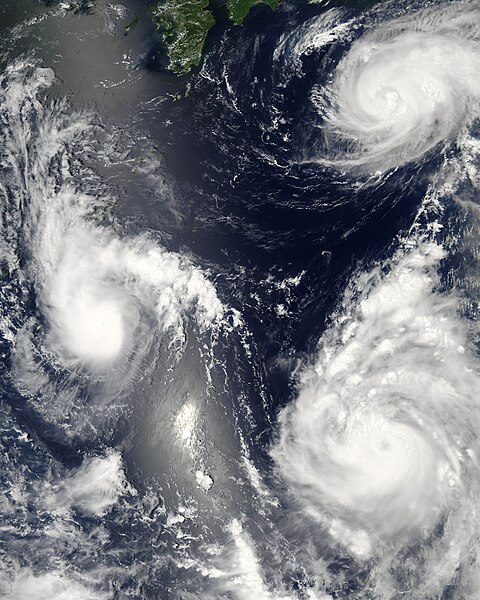File:Maria, Bopha and Saomai 2006-08-07 0435Z.jpg

本预览的尺寸:480 × 600像素。 其他分辨率:192 × 240像素 | 384 × 480像素 | 614 × 768像素 | 819 × 1,024像素 | 1,638 × 2,048像素 | 7,200 × 9,000像素。
原始文件 (7,200 × 9,000像素,文件大小:7.6 MB,MIME类型:image/jpeg)
文件历史
点击某个日期/时间查看对应时刻的文件。
| 日期/时间 | 缩略图 | 大小 | 用户 | 备注 | |
|---|---|---|---|---|---|
| 当前 | 2006年8月8日 (二) 03:06 |  | 7,200 × 9,000(7.6 MB) | Good kitty | == Summary == {{Information |Description=Three different typhoons were spinning over the western Pacific Ocean on August 7, 2006, when the Moderate Resolution Imaging Spectroradiometer (MODIS) on NASA’s Aqua satellite acquired this image. The strongest |
文件用途
以下页面使用本文件:
全域文件用途
以下其他wiki使用此文件:
- ar.wikipedia.org上的用途
- az.wikipedia.org上的用途
- bg.wikipedia.org上的用途
- bh.wikipedia.org上的用途
- crh.wikipedia.org上的用途
- cs.wikipedia.org上的用途
- de.wikipedia.org上的用途
- en.wikipedia.org上的用途
- Typhoon
- Typhoon Saomai
- Tropical cyclone
- Wikipedia:Picture peer review/Archives/Archive2006
- User:Plasticup/MyFavorites
- Typhoon Maria (2006)
- User talk:Hurricanehink/Archive 23
- User talk:Thegreatdr/2012archive
- Wikipedia:Wikipedia Signpost/2013-11-20/Traffic report
- Wikipedia:Wikipedia Signpost/Single/2013-11-20
- Wikipedia:Top 25 Report/November 10 to 16, 2013
- User:Tfmbty/2006 Pacific typhoon season
- User:SongdaTalas/Archives of Former Articles
- en.wiktionary.org上的用途
- es.wikipedia.org上的用途
- fi.wikipedia.org上的用途
- hi.wikipedia.org上的用途
- id.wiktionary.org上的用途
- incubator.wikimedia.org上的用途
- ja.wikipedia.org上的用途
- ja.wikibooks.org上的用途
- ko.wikipedia.org上的用途
- lo.wikipedia.org上的用途
- ms.wikipedia.org上的用途
- my.wikipedia.org上的用途
- nn.wikipedia.org上的用途
- no.wikipedia.org上的用途
- pt.wikipedia.org上的用途
- ro.wikipedia.org上的用途
- ru.wikipedia.org上的用途
- szy.wikipedia.org上的用途
- th.wikipedia.org上的用途
- tk.wikipedia.org上的用途
查看本文件的更多全域用途。






